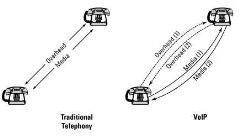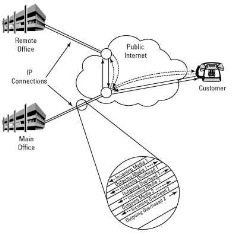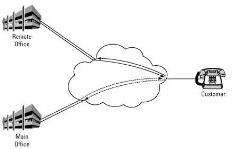VoIP isn’t one single protocol or software package that converts your analog or digital phone call into something that can run over the Internet. VoIP is a group of specialized software elements, each performing a specific task.
Every phone call (whether VoIP or non-VoIP) has two basic components, each using an allotted amount of bandwidth to do its specific job. These call components are
* The voice portion: Also called the media of the call or the payload. The digital, analog, or VoIP representation of your voice is transmitted through the voice portion. Without this part of the call, you can’t hear the words, laughs, sighs, or . . . anything from one end of the call to the other.
* The overhead: Where everything that isn’t the voice portion of the call is transmitted. It handles the housekeeping and maintenance of a call. In this section of bandwidth, the messages to establish the connection of
a call are transferred (called call setup), as well as the mundane task of clearing a call through a network after both parties hang up (called tear-down). This overhead section can also handle a variety of other tasks, such as transmitting codes that translate as ringing, busy signals, or recordings about failed calls (for example, if you dialed a disconnected number). This portion of the call also transmits your Caller ID, as well as the connect and disconnect signals used to begin and end billing on your call.
Figure 1-1 compares the voice and overhead portions of a standard analog and a VoIP phone call.

Figure 1-1:
Analog call and VoIP call comparison.
Figure 1-1 shows how the overhead and media portion of a traditional call are located in a contiguous section of bandwidth from start to finish. When the individual calls enter the network of your long-distance carrier, your call is then routed into a larger circuit, along with hundreds and thousands of other calls. All the calls have a similar structure, in which the bandwidth is portioned out for each element of the call from point to point along the way. The overhead of the call handles all the call setup and tear-down information from both ends of the call, and the media portion of the bandwidth similarly handles transmission of the speech from both ends. While your call is routed from your local phone carrier to your long-distance carrier, and on to the local carrier that services the number you dialed, both elements of the call continue to be bonded together.
Technically, not every non-VoIP call has the voice and overhead portions of the call sandwiched next to each other from start to finish. Several different protocols are used to send and receive traditional telephony calls:

‘ In standard loopstart, groundstart, or E&M wink circuits, Figure 1-1 is an accurate depiction of how a call is transmitted. All of these protocols transmit calls while maintaining the conjoined bandwidth of 64 Kbps for the combined overhead and the voice portion. The unique nature of these three protocols are in the Glossary.
‘ If the call is sent by using ISDN, then the overhead is aggregated on one channel of the circuit, not as a portion of the single channel. The overhead is stripped from the individual calls and given 64 Kbps of bandwidth instead of the minimal room given on a standard telephony call. This allows it to perform all its required duties for many calls, and has additional features that aren’t available with loopstart or groundstart calls.
‘ If the call in Figure 1-1 is sent with SS7 signaling, then it has some of the flexibility of VoIP and a somewhat similar structure, but the overhead is still a continuous stream of data between you and your carrier, not the transmission of overhead packets on an as-needed basis that you see with VoIP.
If you’re interested in finding out more about all these other signaling types, I recommend Telecom For topic (Wiley Publishing, Inc.), by yours truly.
VoIP is structurally different from a traditional telephony call in three ways:
The overhead of the call isn’t bonded to the media of the call, so the overhead and media can be transmitted via completely different routes.
Not only can the overhead of the call find its own way from end to end, it can also be transmitted between different endpoints than the media of a call. The detached nature of the overhead allows for much greater flexibility in call transmission as the voice portion of the call can be easily redirected to a new location while still maintaining the overhead between the same two points.
The overhead of the call (depicted as dashed lines in Figure 1-1) isn’t a constant flow of information in a VoIP call — it’s sent only when needed.
Traditional telephone lines are constantly checking in to both ends of the call to ensure that there aren’t any problems on the line. VoIP is a much more self-confident protocol — it sends the call and transmits additional information to manage the call only when necessary (such as when the call needs to be re-directed or someone hangs up the phone, ending the call).
All media and overhead streams can take their own paths between start and end points. Traditional telephony assigns a section of bandwidth for the overhead and the media transmission of the call. Traditional telephony uses 64 Kbps of bandwidth for every phone call. Once the route path is established, both ends of the call use the same 64 Kbps for the bi-directional transmission of overhead and media. VoIP uses a different design that allows each stream of media or overhead to choose its own path to the destination IP. Because of this stream freedom, Figure 1-1 identifies media and overhead paths with individual directional arrows, rather than the two arrows shown on the traditional telephony call.
These three structural differences allow VoIP calls to be managed and routed in ways a traditional telephony call never could be. VoIP allows you to resend a call from its initial start or end point to a new start or end point. Figure 1-2 shows how a VoIP call can be redirected to another destination. In the example, a call between a remote phone and a business’s main office is then transferred to a remote office.
This traditional mindset about call forwarding has two main problems:
You’re using a lot of unnecessary bandwidth. By accepting the call into your VoIP server at the main office and generating a new call to the remote site, you’re using about 168 Kbps of bandwidth for the two sets of media streams and another 62 Kbps for the two sets of overhead streams. So, this one transmission uses a total bandwidth of approximately 230 Kbps. If you forward calls often, they can start to strain your available bandwidth.
You’re using hardware that can fail or add to the latency of VoIP packet transmissions. Every server interacting on a VoIP call adds a small amount of latency (delay), giving you another variable that you have to consider when troubleshooting calls. Avoid any latency that you can on VoIP calls, such as interaction with unnecessary servers, especially if either network is already over-taxed or you’re transmitting faxes or key pad touch tones (which are highly sensitive to latency).
Problems with intermediary VoIP servers can also kill VoIP calls. VoIP troubleshooting, like all systematic problem-solving in telecom, can quickly degenerate into finger-pointing. Temporarily redirecting the media of a call to completely avoid a network removes that network as a possible source for whatever issue you’re experiencing. If the issue is only present when your call crosses the suspect network, open a trouble ticket and have them resolve the problem. If the problem persists either way, you’ve at least proven that portion of the call to be clean.
Figure 1-3 shows how the standard call from Figure 1-2 should have been transferred. The overhead streams are still spanning between the main office and the customer phone, but the media streams are crossing only from the remote office to the customer, eliminating all latency on the media into and out of the main office and freeing up almost 200 Kbps of bandwidth on the main office IP connection for other calls.

Figure 1-2:Traditional forwarding of VoIP call.

Figure 1-3:A VoIP redirected call.
As useful as this type of redirect is, many carriers don’t like it because it requires their servers to work a bit harder. VoIP redirects the media portion of the call by sending a message to the server at the other end to roll the media to the new location. If you’re a VoIP provider, this can amount to a lot of messages you’re sending to your carrier’s server to redirect the calls. Just like VoIP servers work to eliminate latency on the transmission of calls, the carriers try to reduce how hard their servers have to work.
Beware the rogue media stream. As awe inspiring as it is to see a media stream running off into the ether with no overhead in sight, a media stream can always go rogue. If the end IP destination requested in the redirect message is incorrect, some poor innocent IP is bombarded with a media stream. If the IP isn’t set up to receive VoIP transmissions, the entire stream is probably rejected, with minimal impact to server receiving the unwanted data. If the receiving server is set up to receive VoIP, it might spin out of control and flood it, preventing it from servicing legitimate VoIP calls in an unintentional Denial Of Service (DOS) attack. Even though it wasn’t your goal to overload their server, the RTP still prevented their intended customers from reaching them, so they’ll call it a DOS attack, until we coin another acronym for involuntary SPAM.

